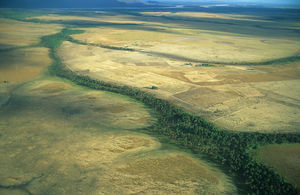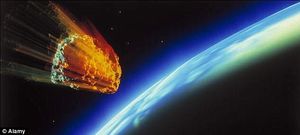- Evidence suggests a meteor or asteroid struck Quebec 12,900 years ago
- This impact caused a change in climate that made Earth colder and drier
- Larger animals died out and humans began eating berries and cereals
- An increase in agriculture and communities led to modern-day civilisation
Evidence suggests a meteor struck Quebec around 12,900 years ago and scientists believe this impact caused the Earth's climate to become colder and drier - known as the Younger Dryas period.
These freezes and droughts led to some larger animals dying out which in turn forced humans to change their diet and develop agricultural methods to cultivate cereal, for example.
Fragments of rock from the meteor are also thought to have released toxic gas which poisoned the air and blacked out the sun, causing temperatures to plummet, plants to die and landscapes to alter forever.
In North America particularly, big animals including mastodons, camels, giant ground sloths and sabre-toothed cats all died out.
The meteor strike is also thought to have caused the demise of the Woolly mammoth.
Human hunters turned to a subsistence diet of roots, berries and smaller game to survive.
Meanwhile thousands of miles away in the eastern Mediterranean, the first farmers started growing cereals.
The scientists claim that this invention of agriculture was a pivotal step in the development of large settled communities and civilisation.

Agriculture in turn enabled humans to take over the planet like a virus and obliterate vast tracts of land.
The new research is said to provide 'conclusive' evidence that the trigger was a meteor impact.
Before now, the most popular explanation has been an ice dam rupture releasing huge amounts of freshwater into the Atlantic.
This in turn was thought to have shut down ocean currents moving warm tropical water, resulting in colder conditions.
Scientists analysed spherules, droplets of solidified molten rock, deposited in Pennsylvania and New Jersey at the start of the Younger Dryas period.
They identified geochemical 'fingerprints' exactly matching the profiles of rock found in southern Quebec.
Although no 'smoking gun' crater had been found, this was a strong clue that the spherules had been created by the massive temperatures and pressures of a meteor impact in Canada.
The findings appear in the journal Proceedings of the National Academy of Sciences.
Professor Mukul Sharma, one of the study authors from Dartmouth College in New Hampshire, US, said: 'The Younger Dryas cooling impacted human history in a profound manner.
'Environmental stresses may also have caused Natufians in the Near East to settle down for the first time and pursue agriculture.'


You need to be a member of 12160 Social Network to add comments!
Join 12160 Social Network